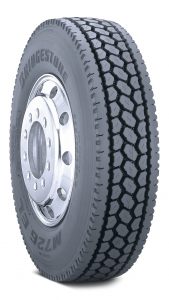Trucks do so many different things. Some run hundreds of miles in a day and never see snow. Others seem to have a date with a mud pit any time the sky gets overcast. For as many ways a truck could possibly earn a dollar, there’s as many variations in the modern commercial tire. Both new tires and retread tread designs have a vast array of SKUS that must be chosen from when the time for replacement finally comes.
The different kinds of tires and tread designs are engineered to do different things well. Take for example, the Michelin XDN2. Here is an Open Shoulder Drive that Michelin designed to run up and down snowy Canadian highways. The lugs on the shoulder made the tires easier to put snow chains on. The compounding allowed traction in cold snow.

The XDN2 however found its way down to Texas, where truck drivers found out that it ran line haul very well, and it now has become one of Michelin’s highest volume products in North America. It is now the drive tire of choice for dual drive, 6*2’s in USA and Canada. There’re loggers out there that if you say “XDN2”, they’re going to think “steer tire”. Now that is just crazy, an Open Shoulder Steer Tire – no, it’s a drive tire, with a lot of ribs down the middle, and a whole lot of sipes for snow-ice bite.
The engineers at Michelin however discovered that although the shoulder lugs allowed the XDN2 to wear like iron on a dual drive 6*2, single drive 6*2’s and 4*2’s were shredding the lugs right off the performance M&S rated tire! For these applications they created a beast: The XDA5. The XDA5 is a Closed Shoulder Drive that can put the torque today’s diesel engines put out to the ground and stay in one piece.

Bridgestone has an often imitated, seldom replicated, high performance drive tire in the line-haul segment that features a Closed Shoulder. The M726EL and the M726 before it, is one of the most imitated drive tires in recent history. Thick, solid, rubber strips on each side of longitudinal ribs made the tire good at bringing big trucks quickly to a stop from highway speeds. The classic long-wearing drive’s tread seems as if the Japanese Engineers that came up with it were asked to make a tread that was one third race car tire, one third steer tire, and one third cat paw.

Another vastly imitated drive tire and a product that dominated wheel positions for decades was Michelin’s XDHT. Somehow Michelin engineers discovered that lateral voids were useless when it came to evacuating water and avoiding hydroplaning. Voids that ran along the direction of rotation however funneled water right out from under big truck drive axles.

Lateral voids do however have a use. Lateral voids create edges that can dig into a loose or “unimproved” surface like a spoon into ice cream, or a bucket on a rented excavator being driven by goldminer crossing a ditch. Dirt, sand, mud, grass, and gravel are all places that expensive drive tires can spin right down to tread-less during take-off. Who knows, an Open Shoulder Drive may allow you to never wish you’d brought your own tow chain!
Thanks for reading!






